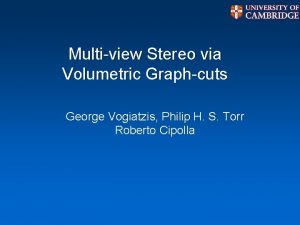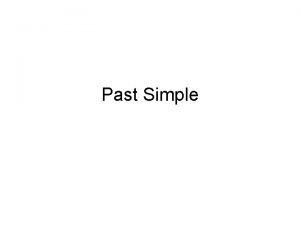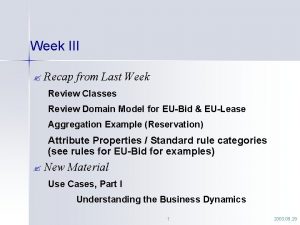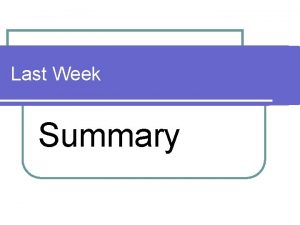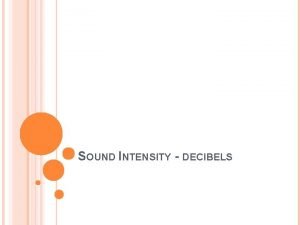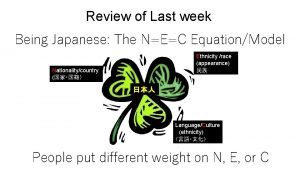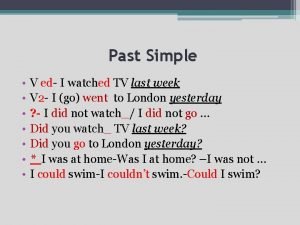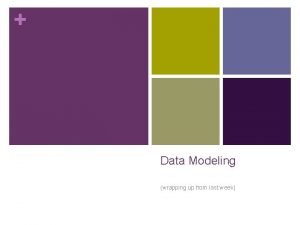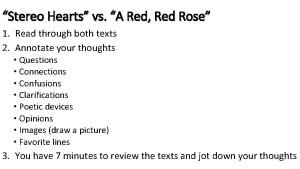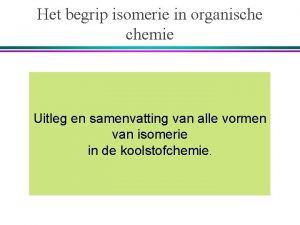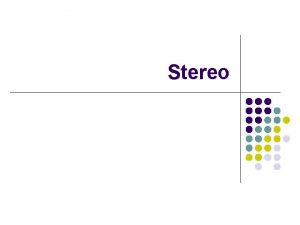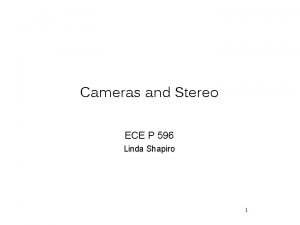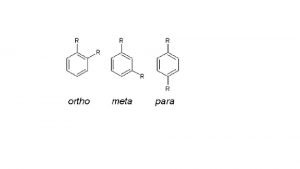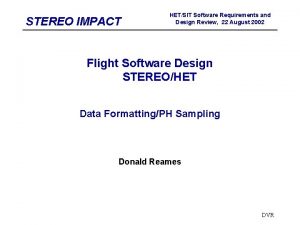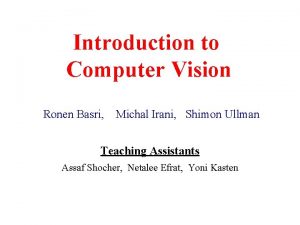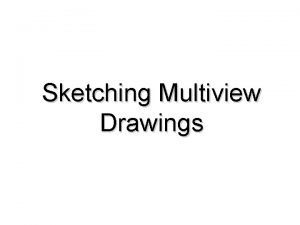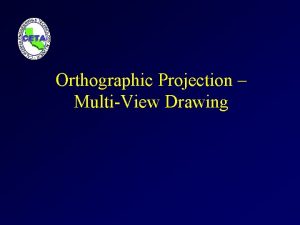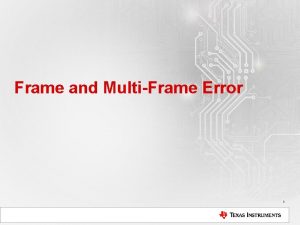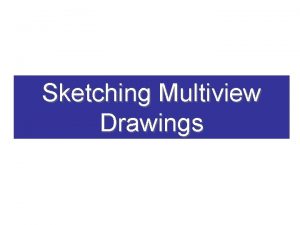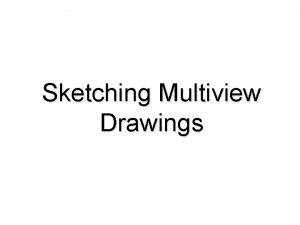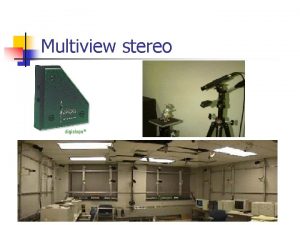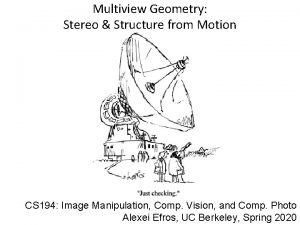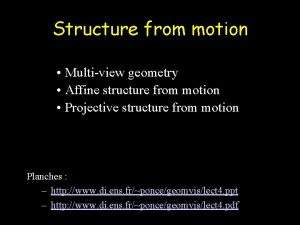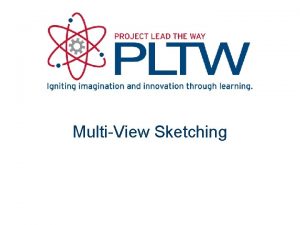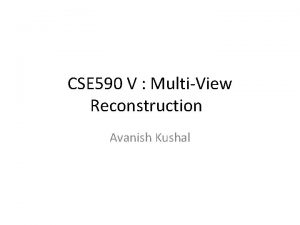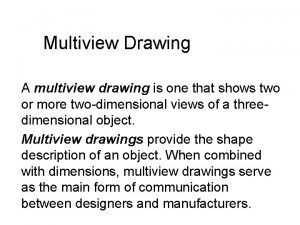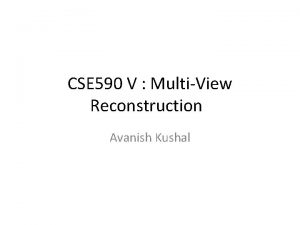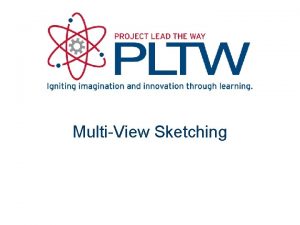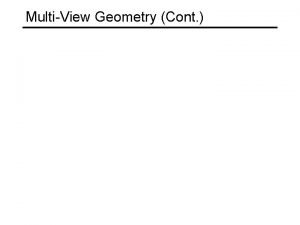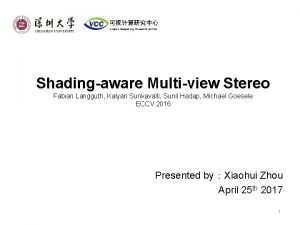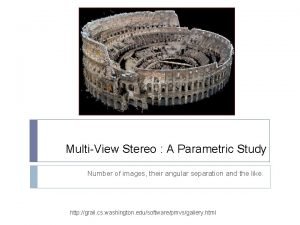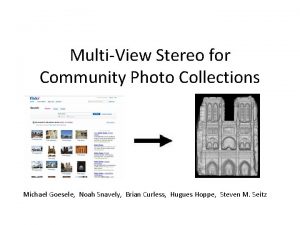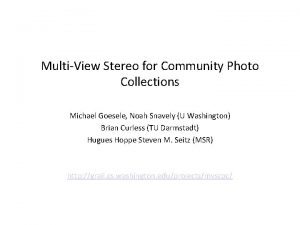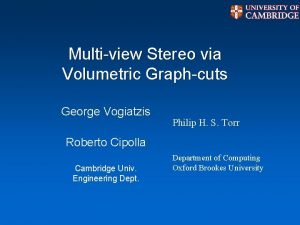Last week MultiFrame Structure from Motion MultiView Stereo















































- Slides: 47

Last week • Multi-Frame Structure from Motion: • Multi-View Stereo Unknown camera viewpoints

Last week • PCA

Today • Recognition

Today • Recognition

Recognition problems • What is it? • Object detection • Who is it? • Recognizing identity • What are they doing? • Activities • All of these are classification problems • Choose one class from a list of possible candidates

How do human do recognition? • We don’t completely know yet • But we have some experimental observations.

Observation 1:

Observation 1: The “Margaret Thatcher Illusion”, by Peter Thompson

Observation 1: The “Margaret Thatcher Illusion”, by Peter Thompson • http: //www. wjh. harvard. edu/~lombrozo/home/illusions/thatcher. html#bottom • Human process up-side-down images seperately

Observation 2: Jim Carrey Kevin Costner • High frequency information is not enough

Observation 3:

Observation 3: • Negative contrast is difficult

Observation 4: • Image Warping is OK

The list goes on • Face Recognition by Humans: Nineteen Results All Computer Vision Researchers Should Know About http: //web. mit. edu/bcs/sinha/papers/19 results_sinha_ etal. pdf

Face detection • How to tell if a face is present?

One simple method: skin detection skin • Skin pixels have a distinctive range of colors • Corresponds to region(s) in RGB color space – for visualization, only R and G components are shown above Skin classifier • A pixel X = (R, G, B) is skin if it is in the skin region • But how to find this region?

Skin detection • Learn the skin region from examples • Manually label pixels in one or more “training images” as skin or not skin • Plot the training data in RGB space – skin pixels shown in orange, non-skin pixels shown in blue – some skin pixels may be outside the region, non-skin pixels inside. Why? Skin classifier • Given X = (R, G, B): how to determine if it is skin or not?

Skin classification techniques Skin classifier • Given X = (R, G, B): how to determine if it is skin or not? • Nearest neighbor – find labeled pixel closest to X – choose the label for that pixel • Data modeling – fit a model (curve, surface, or volume) to each class • Probabilistic data modeling – fit a probability model to each class

Probability • Basic probability • X is a random variable • P(X) is the probability that X achieves a certain value called a PDF -probability distribution/density function -a 2 D PDF is a surface, 3 D PDF is a volume • • or continuous X discrete X • Conditional probability: P(X | Y) – probability of X given that we already know Y

Probabilistic skin classification • Now we can model uncertainty • Each pixel has a probability of being skin or not skin – Skin classifier • Given X = (R, G, B): how to determine if it is skin or not? • Choose interpretation of highest probability – set X to be a skin pixel if and only if Where do we get and ?

Learning conditional PDF’s • We can calculate P(R | skin) from a set of training images • It is simply a histogram over the pixels in the training images – each bin Ri contains the proportion of skin pixels with color Ri This doesn’t work as well in higher-dimensional spaces. Why not? Approach: fit parametric PDF functions • common choice is rotated Gaussian – center – covariance » orientation, size defined by eigenvecs, eigenvals

Learning conditional PDF’s • We can calculate P(R | skin) from a set of training images • It is simply a histogram over the pixels in the training images – each bin Ri contains the proportion of skin pixels with color Ri But this isn’t quite what we want • Why not? How to determine if a pixel is skin? • We want P(skin | R) not P(R | skin) • How can we get it?

Bayes rule • In terms of our problem: what we measure (likelihood) what we want (posterior) domain knowledge (prior) normalization term The prior: P(skin) • Could use domain knowledge – P(skin) may be larger if we know the image contains a person – for a portrait, P(skin) may be higher for pixels in the center • Could learn the prior from the training set. How? – P(skin) may be proportion of skin pixels in training set

Bayesian estimation likelihood • Bayesian estimation posterior (unnormalized) = minimize probability of misclassification • Goal is to choose the label (skin or ~skin) that maximizes the posterior – this is called Maximum A Posteriori (MAP) estimation • Suppose the prior is uniform: P(skin) = P(~skin) = 0. 5 – in this case , – maximizing the posterior is equivalent to maximizing the likelihood » if and only if – this is called Maximum Likelihood (ML) estimation

Skin detection results

General classification • This same procedure applies in more general circumstances • More than two classes • More than one dimension Example: face detection • Here, X is an image region – dimension = # pixels – each face can be thought of as a point in a high dimensional space H. Schneiderman, T. Kanade. "A Statistical Method for 3 D Object Detection Applied to Faces and Cars". IEEE Conference on Computer Vision and Pattern Recognition (CVPR 2000) http: //www-2. cs. cmu. edu/afs/cs. cmu. edu/user/hws/www/CVPR 00. pdf H. Schneiderman and T. Kanade

Linear subspaces convert x into v 1, v 2 coordinates What does the v 2 coordinate measure? - distance to line - use it for classification—near 0 for orange pts What does the v 1 coordinate measure? - position along line - use it to specify which orange point it is • Classification can be expensive • Must either search (e. g. , nearest neighbors) or store large PDF’s Suppose the data points are arranged as above • Idea—fit a line, classifier measures distance to line

Dimensionality reduction How to find v 1 and v 2 ? - PCA Dimensionality reduction • We can represent the orange points with only their v 1 coordinates – since v 2 coordinates are all essentially 0 • This makes it much cheaper to store and compare points • A bigger deal for higher dimensional problems

Principal component analysis • Suppose each data point is N-dimensional • Same procedure applies: • The eigenvectors of A define a new coordinate system – eigenvector with largest eigenvalue captures the most variation among training vectors x – eigenvector with smallest eigenvalue has least variation • We can compress the data by only using the top few eigenvectors – corresponds to choosing a “linear subspace” » represent points on a line, plane, or “hyper-plane” – these eigenvectors are known as the principal components

The space of faces = + • An image is a point in a high dimensional space • An N x M image is a point in RNM • We can define vectors in this space as we did in the 2 D case

Dimensionality reduction • The set of faces is a “subspace” of the set of images • Suppose it is K dimensional • We can find the best subspace using PCA • This is like fitting a “hyper-plane” to the set of faces – spanned by vectors v 1, v 2, . . . , v. K – any face

Eigenfaces • PCA extracts the eigenvectors of A • Gives a set of vectors v 1, v 2, v 3, . . . • Each one of these vectors is a direction in face space – what do these look like?

Projecting onto the eigenfaces • The eigenfaces v 1, . . . , v. K span the space of faces • A face is converted to eigenface coordinates by

Recognition with eigenfaces • Algorithm 1. Process the image database (set of images with labels) • • Run PCA—compute eigenfaces Calculate the K coefficients for each image 2. Given a new image (to be recognized) x, calculate K coefficients 3. Detect if x is a face 4. If it is a face, who is it? • Find closest labeled face in database • nearest-neighbor in K-dimensional space

Choosing the dimension K eigenvalues i= K NM • How many eigenfaces to use? • Look at the decay of the eigenvalues • the eigenvalue tells you the amount of variance “in the direction” of that eigenface • ignore eigenfaces with low variance

Issues: dimensionality reduction • What if your space isn’t flat? • PCA may not help Nonlinear methods LLE, MDS, etc.

Issues: data modeling • Generative methods • model the “shape” of each class – histograms, PCA, – mixtures of Gaussians –. . . • Discriminative methods • model boundaries between classes – perceptrons, neural networks – support vector machines (SVM’s)

Generative vs. Discriminative Generative Approach model individual classes, priors from Chris Bishop Discriminative Approach model posterior directly

Issues: speed • Case study: Viola Jones face detector • Exploits three key strategies: • simple, super-efficient features • image pyramids • pruning (cascaded classifiers)

Viola/Jones: features “Rectangle filters” Differences between sums of pixels in adjacent rectangles { ht(x) = +1 if ft(x) > qt -1 otherwise Y(x)=∑αtht(x) Unique Features Select 200 by Adaboost { Detection = face, if Y(x) > 0 non-face, otherwise Robust Realtime Face Dection, IJCV 2004, Viola and Jonce

Integral Image (aka. summed area table) • Define the Integral Image • Any rectangular sum can be computed in constant time: • Rectangle features can be computed as differences between rectangles

Viola/Jones: handling scale Larger Scale Smallest Scale 50, 000 Locations/Scales

Cascaded Classifier IMAGE SUB-WINDOW 50% 1 Feature F NON-FACE 5 Features F NON-FACE 20% 20 Features 2% FACE F NON-FACE • first classifier: 100% detection, 50% false positives. • second classifier: 100% detection, 40% false positives • (20% cumulative) • using data from previous stage. • third classifier: 100% detection, 10% false positive rate • (2% cumulative) • Put cheaper classifiers up front

Viola/Jones results: Run-time: 15 fps (384 x 288 pixel image on a 700 Mhz Pentium III)

Application Smart cameras: auto focus, red eye removal, auto color correction

Application Lexus LS 600 Driver Monitor System

The class schedule Topics Presenters (two per topic) 10/30 Light Fields 11/1 Photo Quality Assessment Jake, 11/8 Text and Images Yan, Steven 11/13 Shape Descriptor and Matching Brandon, Shengnan 11/27 Labeling Images for fun Yan, 11/29 Indexing and Retrieval of Image Database Steven, Brandon 12/6 Segmentation Jake, Shengnan 12/11 Motion Analysis
 Multiview stereo
Multiview stereo Week by week plans for documenting children's development
Week by week plans for documenting children's development He was _ last weekend
He was _ last weekend What did your partner do last weekend
What did your partner do last weekend Who broke this window
Who broke this window Did you played football
Did you played football Bestie party.com
Bestie party.com We didn't swim yesterday afternoon in spanish
We didn't swim yesterday afternoon in spanish Did you finished your homework
Did you finished your homework Where did you do last weekend
Where did you do last weekend Recap from last week
Recap from last week Last week we installed a kitty door
Last week we installed a kitty door Last week summary
Last week summary Someone gives the school gerbils every year
Someone gives the school gerbils every year Last week of lent
Last week of lent Last week's homework
Last week's homework Last week in japanese
Last week in japanese I watched tv yesterday past simple
I watched tv yesterday past simple Where did you go for your last summer holiday
Where did you go for your last summer holiday The last week of jesus life
The last week of jesus life The doctor gave me a for some medicine last week
The doctor gave me a for some medicine last week He she was were
He she was were Last week
Last week Last week's lesson
Last week's lesson Last week's homework
Last week's homework Tcp stereo
Tcp stereo Simile in stereo hearts
Simile in stereo hearts Dichloor
Dichloor Asymmetrische koolstofatomen
Asymmetrische koolstofatomen Would you mind not smoking
Would you mind not smoking Stereo hearts rhyme scheme
Stereo hearts rhyme scheme Would you mind not talking during the lesson
Would you mind not talking during the lesson Fusion stereo problems
Fusion stereo problems Stereo science center
Stereo science center Photometric stereo
Photometric stereo Stereo
Stereo Stereo luz fm tehuacan
Stereo luz fm tehuacan Geometrinen isomeria
Geometrinen isomeria Stereo vision
Stereo vision Stereo
Stereo Ronen basri
Ronen basri Then i saw the congo creeping through the black meaning
Then i saw the congo creeping through the black meaning A singular noun ending in s x z ch sh
A singular noun ending in s x z ch sh Would you mind not smoking here
Would you mind not smoking here Multiview drawing definition
Multiview drawing definition Define multiview drawing
Define multiview drawing Pgl lincolnshire
Pgl lincolnshire Multi view projector
Multi view projector
